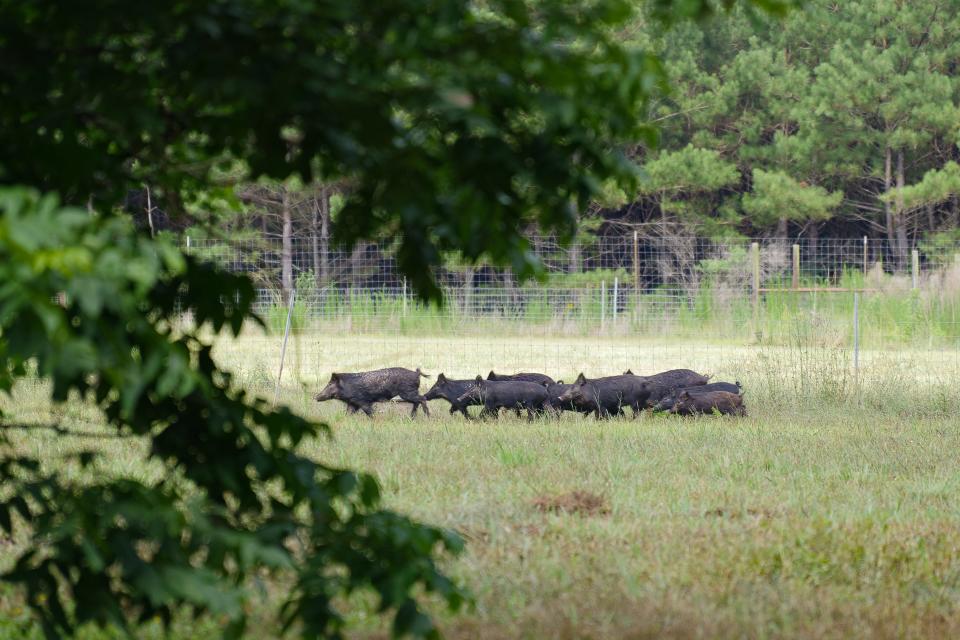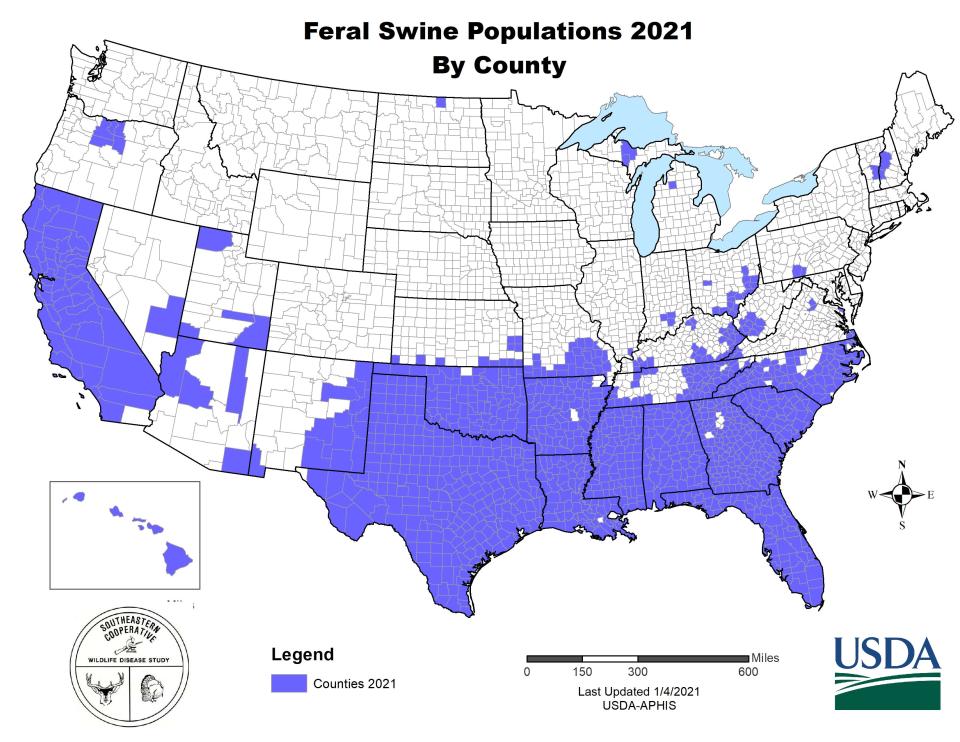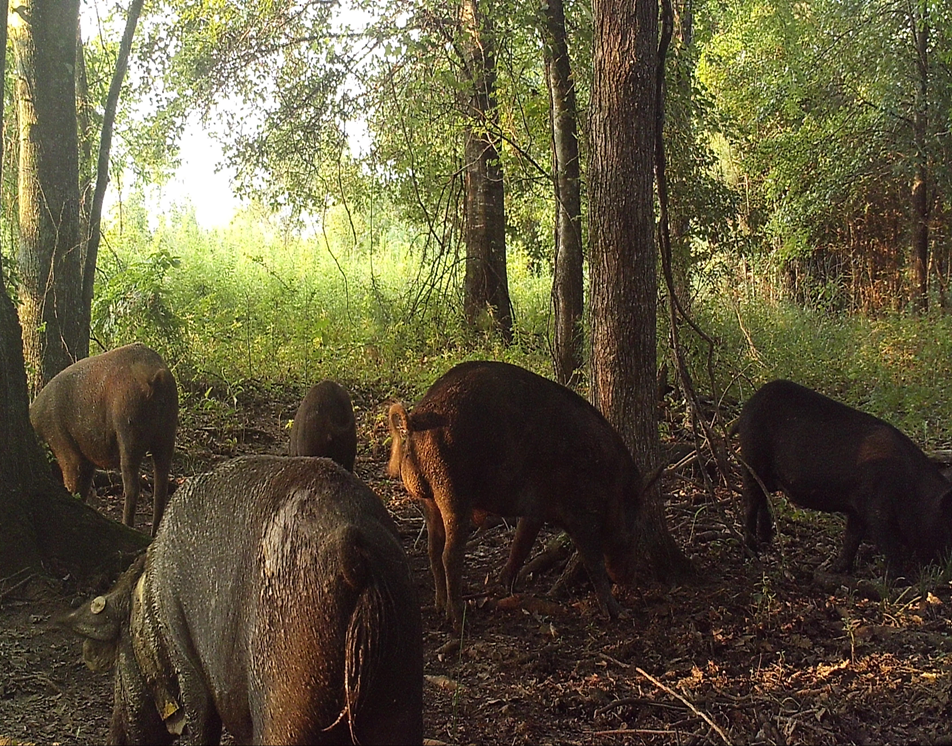Feral hogs are everywhere in Florida, ranked 3rd for most sightings. Is that a problem?
One invasive species is becoming one of the top pests in Florida.
Hunting and fishing website Captains Experiences shared the Top 15 states with the biggest wild hog populations and problems.
Experts used data from the University of Georgia Center for Invasive Species and Ecosystem Health to determine the states with the biggest wild hog problem. Florida nabbed the third spot, seeing 1,193 reports of feral hogs last year.
Texas saw the top spot on the list, with 2,425 feral hog reports throughout 253 of its counties. Georgia grabbed the second place title with 1,377 reports of feral hogs. Other states rounding out the Top 5 included Mississippi and Oklahoma.
Florida’s most wanted: State's invasive species list includes giant snails, pythons, feral hogs
What are feral hogs?

The feral hog is defined in Florida Fish & Wildlife Conservation Commission regulations as a "hog that is free-roaming and which cannot be legally claimed as a domestic hog in private ownership." They can also be called a wild hog, feral swine, feral pig, wild boar, wild pig or piney woods rooter.
They can reach weights of more than 150 pounds and be 5 to 6 feet long. They usually travel in small family groups (called sounders) or alone. Feral hogs are prolific breeders and can maintain large populations.
According to the U.S. Department of Agriculture, these are one of the most destructive and formidable invasive species in the country. While hogs mostly eat plants, their habit of rooting under the ground can cause considerable damage to native ecosystems.
How did feral hogs come to the United States?
Florida's feral hogs can trace their lineage back to the times of the Spanish conquistadors of the 16th century. Early European settlers brought livestock to the Americas, including pigs, and some of them escaped into the wild as settlers expanded into the region.
It's also noted in the study that Russian boars were introduced to the U.S. in the 1900s for sport hunting. Interbreeding between escaped domestic pigs and boars has created hybrids with the strongest characteristics of each.
Are Florida hogs aggressive or dangerous to humans?
Yes.
Feral pigs are known to be dangerous to people, particularly when the pigs travel in herds with their young. They have been known to be aggressive toward dogs and other pets as well.
The U.S. Department of Agriculture also writes that feral swine can carry at least 30 diseases and nearly 40 types of parasites that may affect people, pets, livestock and wildlife. Some diseases, such as pseudorabies, are fatal to cats and dogs that may be exposed from direct contact with a feral swine carcass.
Does Florida have a feral hog problem?
Yes, majorly.
The University of Florida wrote that they will eat almost anything, including dead animals but natural foods are scarce or inaccessible, hogs will forage on almost any agricultural crop and livestock feed.
This means they can feed on tree seeds and seedlings, causing significant damage in forests, groves and plantations. In Florida and the Southeast, this is a problem in regenerating long-leaf pine forests.
In addition to the effects of consuming, knocking down and trampling large amounts of native vegetation and crops, UF writers also noted the rooting behavior of wild hogs causes significant damage.
"Rooting — digging for foods below the surface of the ground — destabilizes the soil surface, uprooting or weakening native vegetation, damaging lawns and causing erosion," Bill Giuliano, a professor of wildlife ecology at the University of Florida’s Institute of Food and Agricultural Sciences, said. "Their wallowing behavior destroys small ponds and stream banks, which may affect water quality. They also prey upon ground-nesting wildlife, including sea turtles."
Where are the most hogs in Florida?

Wild hogs are found in all 67 counties of Florida.
Florida Online Journals says some of the highest hog population densities in Florida can be found north and west of Lake Okeechobee. This is due to the area's large forested tracts, dense understory vegetation, and limited public access.
Can you hunt feral pigs in Florida?
Wild hogs may be trapped and hunted year-round with landowner permission, according to the FWC.
A hunting license is not required, and a permit is not required to take wild hogs at night with a gun and light with landowner permission. Hunters may use dogs and any legal rifle, shotgun, crossbow, bow, pistol or air gun.
There is no size or bag limit, and either sex may be harvested.
Are Florida wild hogs safe to eat?
Feral hogs can be eaten for their meat, but you need to harvest and process them safely.
The Centers for Disease Control and Prevention cites brucellosis as the main risk to humans who consume wild game. Wild hogs, elk, bison, caribou, moose and deer can all potentially carry the bacteria, which can cause fever, chills, weight loss, and joint and muscle pain.
To cook feral hog, the CDC recommends cooking the meat to an internal temperature of 160 degrees. They recommend the following guidelines when handling wild hogs:
Use clean, sharp knives for field dressing and butchering.
Wear eye protection and rubber or latex gloves (disposable or reusable) when handling carcasses.
Avoid direct (bare skin) contact with fluid or organs from the animal.
Avoid direct (bare skin) contact with hunting dogs that may have come into contact with hunted animals.
After butchering, burn or bury disposable gloves and parts of the carcass that will not be eaten.
Don’t feed dogs with raw meat or other parts of the carcass.
Wash hands as soon as possible with soap and warm water for 20 seconds or more. Dry hands with a clean cloth.
Clean all tools and reusable gloves with a disinfectant, like dilute bleach. (Follow the safety instructions on the product label).
Thoroughly cook meat from any animal that is known to be a possible carrier of brucellosis.
Be aware that freezing, smoking, drying and pickling do not kill the bacteria that cause brucellosis.
What should I do if I have wild hogs near my house or on my property?

The FWC says that trying to prevent wild hogs from coming onto your property can be difficult, but adequate fencing should keep them out of small yards and gardens.
If you do have a problem with feral hogs near your property, you will want to reach out to a wildlife trapper for immediate removal.
What should I do if I run into a feral hog?
Wildlife website StoneAge Man shared these tips from survivors of pig attacks:
First, if you see a pig approaching from a distance, run away. Keep in mind that they’re fast, so this won’t work if they’re already very close.
If they continue approaching you, try to get up a tree. They can’t climb, so 6 feet up and you’re probably safe.
If there are no trees around, stand your ground and prepare to fight the pig. If you don’t have a gun, knife or spear, use anything you have. This might include a tripod, bike, shovel, or dog leash. Try your best and never give up.
Stay on your feet. If you fall, you risk getting a tusk in the gut, arms, head or neck.
Keep fighting until the pig stops. Often attacks only last a minute.
Get first aid immediately. Not only do you need to prevent blood loss, but pigs carry a lot of harmful bacteria in their mouths that could cause serious problems if untreated.
This article originally appeared on Fort Myers News-Press: Wild hogs are taking over Florida. Is it safe to eat feral swine meat?

